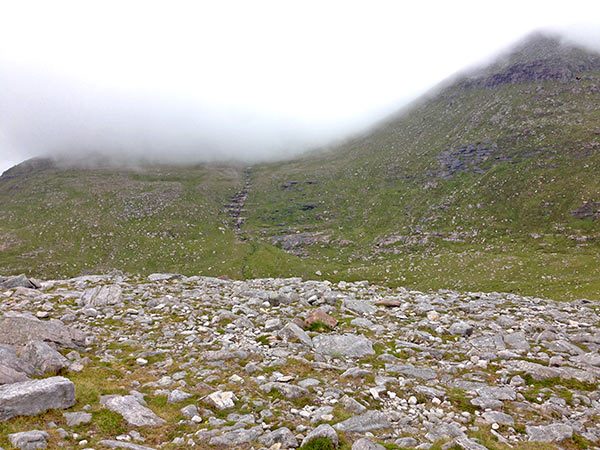I was delighted to be voted the winner of the ‘Rare Species’ category in the BSBI’s (Botanical Society of Britain & Ireland’s) 2016 Photographic Competition with a shot of Norwegian Mugwort Artemisia norvegica.
It all started around 20 years ago when Anne found a copy of A Colour Guide to Rare Wild Flowers by the late John Fisher in a secondhand bookshop. This is a wonderfully-written little book, illustrated by the author’s own photographs. I understand that after it was published in 1991 the author was ‘hounded out’ of the BSBI for spilling the beans, albeit usually rather vaguely, about the localities of rare plants. How times have changed: the BSBI actively encourages the publication of county ’Rare Plant Registers’, many of which list localities with 8- or even 10-figure grid references. Anyway, Norwegian Mugwort is found on page 322 of Fisher’s book: ‘It is worth a week’s hard labour to see the smiling face of this rarity, gazing like a miniature sunflower across one of the handful (some say two sites only) of sandstone boulders over which it presides.’ With this sentence Norwegian Mugwort became the stuff of dreams, inaccessible in its remote Scottish fastness.
I recent years I have become a bit addicted to mountain flowers, perhaps because of the contrast with Norfolk, and in summer 2016 managed to get away for a while mid-summer for a trip to northern Scotland. I am always a bit nervous in advance of a mountain excursion. Not only are there real hazards (weather, cliffs, scree) and I am typically on my own, but also because according to some of the write-ups that you can find on the web nowadays searching for alpines involves horrendously long walks to impossibly dangerous places.
Norwegian Mugwort is closely related to Mugwort A. vulgaris, one of the commonest weeds, but is much, much rarer. It is only know from three sites in Scotland and from Norway and the northern Urals, and was discovered in Britain as recently as 1950.The best-know site for Norwegian Mugwort is the mountain of Cul Mor, in the Inverpolly region to the north of Ullapool. Cul Mor is 849m high, so not a ‘Munro’, but it sits in splendid isolation and looks pretty special. Its geology is special too, as it is largely made up of Torridonian Sandstones deposited around a billion years ago. These sandstones are constantly eroding, and near the summit of Cul Mor I found an area of loose sand that resembled a beach – picking up a handful of sand it was amazing to think that it had first been eroded from long-gone mountains over 1,000,000,000 years ago.
I had allowed two days to climb Cul Mor to allow for bad weather – I now think that this was optimistic – but I was lucky. It was amazingly hard to find accommodation in the area, and in the end I booked a room in the dorm at Acheninver Hostel, in a stunning location around 40 minutes drive away down single-track roads. On the first allotted day the cloud base was very low and rain was forecast for most of the day, so I gave up on the mountain and headed to the north coast and fine weather. The second day did not look much better early on, but the forecast was OK so I parked up at Knocken and set off. I could not see the mountain, but the path was obvious, at least for a while.

“It’s up there somewhere…” Looking towards Cul Mor and the col to the south from the stony summit of Meallan Diomhain.
The first obstacle is the summit of Meallan Diomhain, a rounded, stony hill. It was still misty, but a series of cairns marked the way. From here on however there was no path and it was a matter of ‘yomping’. I could still see neither the summit nor the col to the south that I needed to find, but I ploughed on, optimistic. Fortunately, the mist started to lift from time to time and I could get my bearings, so onwards and up a rather steep slope and eventually the col to the south of the main peak. I did have directions from there, but they were ridiculously complicated and would only work in fine weather, as you had to use islands and mountains many miles away as guides! It was much, much simpler to look for the habitat – flat, very stony areas littered with eroded sandstone boulders – on the steep-sided shoulder of the mountain than projects to the north-west of the summit. Once in the habitat Norwegian Mugwort was common – I think that I saw 250 plants – and contrary to reports a lot were flowering, or at least had flowered but were now going to seed. What’s more, the cloud was now well and truly lifting and the afternoon ended up sunny, calm and warm.
I spent around four hours wandering around, taking photos of mugworts and a few other alpines, although Cul Mor has a rather limited flora, and just enjoying the place and the view. All too soon it was time to head back down, with more stops for photos. I was back at the car after a ten-and-a-half hour round trip to be greeted by the only midges of the trip. I only saw two people all day, the second a local who told me that this was the first time that the summit had been visible for a fortnight. So, good luck with the weather, a stunning mountain and an intriguing plant: brilliant.




